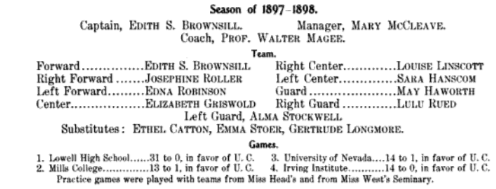Edith Brownsill, M.D., was born in Wisconsin, according to her passport application. A graduate of Santa Barbara High School in California, she enrolled at the University of California Berkeley.
While at Berkeley, she captained the women’s basketball team, before Cal had a men’s team and light years before Title IX and the emergence intercollegiate teams for women. The game was a young one, having been invented only a few years before. The Blue and Gold yearbook has this about the 1898 team which Brownsill captained:
Previous numbers of the Blue and Gold have been unanimously quiet upon the subject – and indeed the sport itself is not very prominent among College Interests. The basket ball players make very little noise in College – between games – and the management has not made very vigorous endeavors to bring the game to the notice of the College as a whole. We think the apathy of the men students in regard to the game has been overestimated, and that, if a determined effort were made, a number of them would be found to have sufficient College spirit to purchase tickets and attend the games.
Although the indoor pig-skin chasers do not strive for the glaring publicity which so delights their brethren of the football field, the University of California team occupies a proud position in basket ball circles – an eminence so lofty that they can uniformly dictate the conditions on which others may contest with them, and just as uniformly emerge victorious from the struggles in which they engage.
While we regret that intercollegiate contests seem impossible, unless Stanford will recede from her unreasonable position and consent to our conditions, we all feel that it is real mean of her to so persistently put forward the claim that it is now our turn to concede something – a claim do clearly advantageous to herself.




San Francisco Examiner, December 14, 1897
More information about the team and its games can be found here. No backboards is one of the reasons for the low scores.
And thought it’s nowhere in her biography, it appears that Brownsill spent some time, maybe months, maybe a year, coaching the University of Nevada Reno basketball team. The 1899 women’s basketball team gave the UNR its first official intercollegiate sports victory.

University of Nevada Reno 1899 basketball team
Brownsill enrolled at the University of California Medical School and graduated in 1904. She then interned at the Children’s Hospital in San Francisco from 1904-1905. She was affiliated with the Berkeley Dispensary General Medicine 1906-1922. In 1917, she interned for three months at Johns Hopkins and a month at the Lying-in Hospital in New York City.

Brownsill became an honorary member of the Omicron chapter of Alpha Gamma Delta when it was chartered on March 12, 1915. She often served as a speaker for chapter and alumnae events.

In 1922, she limited her practice to Obstetrics and Infant Feeding. The Western Outlook in March 1922 reported, “A large gathering of women and girls were out Tuesday night to hear the talk on ‘Sex Hygiene,’ by Dr. Edith Brownsill.”
Brownsill was affiliated with the Alta Bates Sanitarium beginning in 1905. It was there that she died on April 26, 1926 at the age of 54. One report noted:
She had been in failing health, but went to Europe and came back better. She apparently fainted while attending a patient. Another doctor tried to revive her but was unsuccessful.
The Alameda County Medical Association set aside time in its regular program to give a tribute written by May E. Walker:
For 21 years she shared with us all the ministry of healing, She was, in the fullest sense, a beloved physician. For her the practice of medicine was a constant search for more abundant life who came to her for counsel and care. She never asked what her work would bring her; never sought to build up a moneyed clientele; made no plans on anticipated returns. For her the art of healing was an end in itself; the patient was the means, regardless of wealth, class or culture. Her work was never a task imposed, but rather a cherished privilege. To a real degree she possessed that depth of spirit which always inspires confidence; her very presence in the sickroom meant that ‘hearts were brave again and arms were strong.’
Her babies loved her with the fine discrimination of child affection and, although to them a doctor’s office meant discomfort if not actual pain, her tenderness beguiled their fears. To their mothers she was strength, courage and assistance. She inspired her association with realizable ideals and fine standards of performance. Hers was a ministry of work and of work done to the very fullness of ability. In this high endeavor she spent herself, careless of weariness, lowering resistance and waning vitality. This she came to the close of her career a victorious exponent of the noble challenge, ‘I am among you as one who serveth.’ She left no family in the sense of blood relations, but hers was the great family of devoted patients who loved her for herself. Doctor Brownsill’s life will continue ion its ministry through the many whose lives she touched. Hers is indeed a precious memory.
